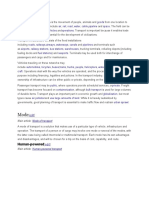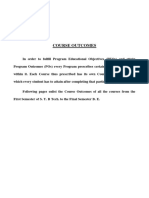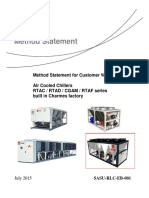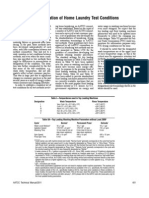Water Transport and Air Transport
Water Transport and Air Transport
Uploaded by
Ashish ShettyCopyright:
Available Formats
Water Transport and Air Transport
Water Transport and Air Transport
Uploaded by
Ashish ShettyOriginal Description:
Original Title
Copyright
Available Formats
Share this document
Did you find this document useful?
Is this content inappropriate?
Copyright:
Available Formats
Water Transport and Air Transport
Water Transport and Air Transport
Uploaded by
Ashish ShettyCopyright:
Available Formats
INTRODUCTION :
Transport of transportation is the movement of goods and people from one location to another. Transportation plays a major role in the economy, which increases the production efficiency and links to the logistics system. There are many different modes of transportation, however, they are devided into 3 basic types depending on over what surface they travel: land, water, and air.
Water transport is one of the oldest means of transport in India. Prior to the advent of rail and road transports, goods and people were moved from one place to another through water transport. Since there is almost very small cost involved in the construction and maintenance of waterways this transport system is always cheaper. According to one estimate the construction of each km of railway and road needs an investment of Rs. 1.0-1.5 crores and Rs. 0.60-0.75 crore respectively whereas only Rs. 0.10 crore is required to develop same length of waterways. Their development is faster and maintenance cost much lower. Waterways are of two types: (a) Inland waterways, and (b) Sea ways or ocean ways also called shipping. Water transportation is the intentional movement of water over large distances. Methods of transportation fall into three categories:
Aqueducts, which include pipelines, canals, and tunnels, container shipment, which includes transport by tank truck, tank car, and tank ship, and towing, where a tugboat is used to pull an iceberg or a large water bag along behind it.
Due to its weight, the transportation of water is very energy intensive. Unless it has the assistance of gravity, a canal or long-distance pipeline will need pumping stations at regular intervals. In this regard, the lower friction levels of the canal make it a more economical solution than the pipeline. Water transportation is also very common along rivers and oceans.
Air transport is the fastest mode of transport which has reduced distances and converted the world into one unit. But it is also the costliest mode of transport beyond the reach of many people. It is essential for a vast country like India where distances are large and the terrain and climatic conditions so diverse. Civil Aviation in India started in 1911 when Mail (Dock) was for the first time carried by air from Allahabad to Naini. In 1920 the organised air transport service was started. In 1927 Civil Aviation Department was set up on the recommendation of Air Transport Council. In 1932 Tata Airways Limited introduced air services between Karachi and Lahore. In 1928 Flyings Clubs were opened in Delhi, Karachi, Kolkata and Mumbai. Aviation is the design,
development, production, operation, and use of aircraft, especially heavier-than-air aircraft. The word "Aviation" was coined by french writer and former naval officer Gabriel La Landelle in 1863, from the verb "avier" (synonymous flying), itself derived from the Latin word "avis" ("bird") and the suffix "-ation".
CONTENT : Water
transport is the process of transport a watercraft, such as a barge, boat, ship or sailboat, over a body of water, such as a sea, ocean, lake, canal or river. The need for buoyancy unites watercraft, and makes the hulla dominant aspect of its construction, maintenance and appearance. Ship transport is primarily used for the carriage of people and non-perishable goods, generally referred to as cargo.
In the 1800s the first steam ships were developed, using a steam engine to drive a paddle wheel or propeller to move the ship. The steam was produced using wood or coal. Now most ships have an engine using a slightlyrefined type of petroleum called bunker fuel. Some ships, such as submarines, use nuclear power to produce the steam. Recreational educational craft still use wind power, while some smaller craft use internal combustion engines to drive one or more propellers, or in the case of jet boats, an inboard water jet. Inshallow draft areas, hovercraft are propelled by large pusher-prop fans. or Although slow, modern sea transport is a highly effective method of transporting large quantities of non-perishable goods. Commercial vessels, nearly 35,000 in number, carried 7.4 billion tons of cargo in 2007. Transport by water is significantly less costly than air transport for trans-continental shipping. A cargo ship sailing from a European port to a US one will typically take 10-12 days based on water currents and other factors. Sea transport remains the largest carrier of freight in the world.
1. Important for Foreign Trade: Current volume of India's trade is quite large and it is likely to further expand for the sake of economic development of the country. So, its importance cannot be under-rated. 2. Foreign Exchange: Shipping has also enabled the country to save enough of foreign exchange. Foreign exchange is of utmost importance for country's economic development. India has already been facing acute foreign exchange shortage. 3. Defense: Development of shipping is essential for the defense of the country also. It is regarded as second line of defense. 4. Cheap Means of Transport: Water transport is the cheapest means of transport. Oceans and rivers are the free gifts of nature. No cost is involved in their construction unlike that of railways and roads. 5. Transport of Heavy Goods: Heavy and bulky goods can be transported at little cost through water transport. 6. Useful during Natural Calamities: During natural calamities like floods, heavy downpour etc. when rail or road transport is disrupted, water transport alone is possible. 7. Less maintenance Cost: Compared to other means of transport, maintenance cost of water transport is very little.
1. Limited Area: Area of water transport is restricted. Rivers and oceans are free gifts of nature. Accordingly the operational area remains fixed. Unlike railways and roads, man cannot construct waterways.
2. Slow Speed: It is a slow means of transport. Failure of monsoon results into fall in the water-level of rivers making navigation difficult. 3. Less Safety: As against other means of transport, it is less safe. Danger of sinking of boats and ships always looms large.
The aircraft is the second fastest method of transport, after the rocket. Commercial jets can reach up to 875 kilometres per hour (544 mph), single-engine aircraft 175 kilometres per hour (109 mph). Aviation is able to quickly transport people and limited amounts of cargo over longer distances, but the disadvantage is high costs and energy use. Air freight has become more common for products of high value; while less than one percent of world transport by volume is by airline, it amounts to forty percent of the value. Time has become especially important in regards to principles such as postponement and just-in-time within the value chain, resulting in a high willingness to pay for quick delivery of key components or items of high value-toweight ratio. In addition to mail, common items send by air include electronics and fashion clothing.
1. High Speed: It is a high speed means of transport. Passengers and goods can be transported speedily from one place to the other. 2. Transport of Costly and Light Goods: It is convenient to send costly, light and perishable goods through air transport. 3. Minimum Cost: Unlike railways and road transport there is no need to spend any money on the construction of any track or road. One has only to construct air-ports. 4. Free from Geographical Constraints: Mountains oceans and rivers create no obstruction to air transports. 5. Useful for Agriculture: Aeroplanes are used to make aerial spray of pesticides and insecticides. 6. Strategic Importance: It has great strategic significance. Soldier, arms and ammunition can be airlifted to the troubled spots.
I. Risky: Air transport is the most risky form of transport because a minor accident may put a substantial loss to the goods, passengers and the crew. The chances of accidents are greater in comparison to other modes of transport. II. Very Costly: Air transport is regarded as the costliest mode of transport. The operating cost of aero-planes are higher and it involves a great deal of expenditure on the construction of aerodromes and aircraft. Because of this reason the fare of air transport are so high that it becomes beyond the reach the common people. III. Small Carrying Capacity: The aircrafts have small carrying capacity and therefore these are not suitable for carrying bulky and cheaper goods. the load capacity cannot be increased as it is found in case of rails. IV. Unreliable: Most of the air transport are uncertain and the unreliable because these are controlled by weather condition. It is seriously affected by adverse weather conditions. Fog, snow and heavy rain weather may cause cancellation of some flights. V. Huge Investment: Air transport requires huge investment for construction and maintenance of aerodromes. It also requires trained, experienced and skilled personnel which involves a substantial investment.
CONCLUSION :
Biblography :
You might also like
- Introduction of Air TransportDocument15 pagesIntroduction of Air TransportJitendra Gurjar71% (7)
- SAP IM Vs WM, How To Choose Use and OptimizeDocument56 pagesSAP IM Vs WM, How To Choose Use and Optimizehalwanv100% (1)
- Modes of Transportation in Logistics ContinuedDocument12 pagesModes of Transportation in Logistics ContinuedBassma EL GHALBZOURI100% (1)
- High Angle Conveyor Offers Mine Haulage SavingsDocument27 pagesHigh Angle Conveyor Offers Mine Haulage SavingsJDNo ratings yet
- Assess The Advantages and Disadvantages of Road, Rail, Air and Water Transport Within or Outside Pakistan For Both Goods and PeopleDocument10 pagesAssess The Advantages and Disadvantages of Road, Rail, Air and Water Transport Within or Outside Pakistan For Both Goods and PeopleSalman Farsi100% (8)
- PAT Drilling Rig List (PAT)Document24 pagesPAT Drilling Rig List (PAT)Francisco Salvador MondlaneNo ratings yet
- Water Transport Is The Cheapest and The Oldest Mode of TransportDocument6 pagesWater Transport Is The Cheapest and The Oldest Mode of TransportSmrith Aradhana100% (2)
- Compiled By:-: Harshita Kankane Shweta Ghanshani Jyoti Thapar Nitesh Daga Anupam DubeyDocument75 pagesCompiled By:-: Harshita Kankane Shweta Ghanshani Jyoti Thapar Nitesh Daga Anupam DubeyShweta GhanshaniNo ratings yet
- Paper 1 Unit 4 - Transport ManagementDocument37 pagesPaper 1 Unit 4 - Transport ManagementSatyam MuleNo ratings yet
- Introduction To Transport TechnologyDocument34 pagesIntroduction To Transport TechnologyØlàmìflòw ÕshãNo ratings yet
- DESIGN OF WATER TRANSPORTATION FACILITIES (Group-8)Document13 pagesDESIGN OF WATER TRANSPORTATION FACILITIES (Group-8)Bryan YuNo ratings yet
- السَّلاَمُ عَلَيْكُمْ وَرَحْمَةُ اللهِ وَبَرَكَاتُهُمَةُDocument10 pagesالسَّلاَمُ عَلَيْكُمْ وَرَحْمَةُ اللهِ وَبَرَكَاتُهُمَةُAldi Tri Budi wibowoNo ratings yet
- Types of Transport: Mode of Transport Is A Term Used To Distinguish Between Different Ways of TransportationDocument3 pagesTypes of Transport: Mode of Transport Is A Term Used To Distinguish Between Different Ways of TransportationSnehil ParmarNo ratings yet
- WATER TRANSPORTATION Week 7Document3 pagesWATER TRANSPORTATION Week 7gabriellandupuNo ratings yet
- Road Transport AdvantagesDocument3 pagesRoad Transport AdvantagesKetan DeshmukhNo ratings yet
- Water Transportation 3Document9 pagesWater Transportation 3thanosnose2005No ratings yet
- HM Pe 2 Chapter 3Document11 pagesHM Pe 2 Chapter 3jefrey antioquiaNo ratings yet
- Transportation ModesDocument5 pagesTransportation Modesmichaelurassa666No ratings yet
- Transportation Engineereing Lect AssigDocument7 pagesTransportation Engineereing Lect Assigkiran khanNo ratings yet
- Transportation: Srinivas Thadoju Roll No 133040009 M.Tech Transportation Systems Engineering IIT Bombay (Assignment 1)Document11 pagesTransportation: Srinivas Thadoju Roll No 133040009 M.Tech Transportation Systems Engineering IIT Bombay (Assignment 1)Aryanth ReddyNo ratings yet
- ITEM NO. 1 - Mode of TransportDocument25 pagesITEM NO. 1 - Mode of TransportPatricia TubangNo ratings yet
- Alternative Fuel VehiclesDocument24 pagesAlternative Fuel Vehiclesumernaqqash86No ratings yet
- Ocean TransportationDocument10 pagesOcean TransportationJessa CapangpanganNo ratings yet
- TransportDocument7 pagesTransportBikramjit MajumdarNo ratings yet
- Land Transportation: Elbanar Badr Chtaini IdrisseDocument19 pagesLand Transportation: Elbanar Badr Chtaini IdrissematrixleblancNo ratings yet
- Development in TransportDocument5 pagesDevelopment in TransportSubramani RajaNo ratings yet
- Referat Transport EnglezaDocument6 pagesReferat Transport EnglezawithusernameNo ratings yet
- Transportation Types Advantages and Disadvantages InformationDocument5 pagesTransportation Types Advantages and Disadvantages InformationJasvinder SinghNo ratings yet
- Mode of TransportDocument6 pagesMode of TransportBibithaNo ratings yet
- Guided By: Prof. Seema Vyas: Presented By: Divya AgarwalDocument39 pagesGuided By: Prof. Seema Vyas: Presented By: Divya AgarwalDivya AgarwalNo ratings yet
- Water Transportation SystemDocument13 pagesWater Transportation Systemrakesh kumarNo ratings yet
- 2.1 History of Birth and Development of Sea TransportDocument6 pages2.1 History of Birth and Development of Sea TransportromtdNo ratings yet
- Comapritive Study of Air India and Indi GoDocument66 pagesComapritive Study of Air India and Indi GoJunaid KhanNo ratings yet
- Janakpur Engineering College: Tathali, BhaktapurDocument4 pagesJanakpur Engineering College: Tathali, BhaktapurRohit Kumar SahNo ratings yet
- Transportation 1Document23 pagesTransportation 1gmookambigaiNo ratings yet
- Water TransportationDocument5 pagesWater TransportationabbamuhammadgarkiNo ratings yet
- Introduction To The SeminarDocument17 pagesIntroduction To The SeminarAditya BhandareNo ratings yet
- Transport 1Document5 pagesTransport 1leloba mhlauliNo ratings yet
- C & M TransportDocument10 pagesC & M TransportNavodya EdirisuriyaNo ratings yet
- Transport or Transportation Is The Movement of People, Animals andDocument14 pagesTransport or Transportation Is The Movement of People, Animals andHarleen KaurNo ratings yet
- Homeread (1) TransportDocument11 pagesHomeread (1) TransportTrading TradingNo ratings yet
- Human-Powered: Mode of TransportDocument4 pagesHuman-Powered: Mode of Transportdash1991No ratings yet
- 1U-Challenges and advantages of air cargo in comparison with sea cargoDocument5 pages1U-Challenges and advantages of air cargo in comparison with sea cargoNguyễn UyênNo ratings yet
- Kiran KV New ProjectDocument14 pagesKiran KV New ProjectKiran SankarNo ratings yet
- Development of Transportation Transport or Transportation Is The Movement of People, AnimalsDocument13 pagesDevelopment of Transportation Transport or Transportation Is The Movement of People, AnimalsJohn AjishNo ratings yet
- Lesson 7 Bus Stud JS3 FT - TransportationDocument23 pagesLesson 7 Bus Stud JS3 FT - Transportationandriehinston518No ratings yet
- Water TransportDocument4 pagesWater Transport福发No ratings yet
- UNIT I - BBA 4 - 5 Commonly Used Transport ModesDocument9 pagesUNIT I - BBA 4 - 5 Commonly Used Transport ModesMuchaelNo ratings yet
- 19261_WEEK 4 NOTEDocument4 pages19261_WEEK 4 NOTEangelNo ratings yet
- Wk+9+ +Sea+TransportationDocument7 pagesWk+9+ +Sea+TransportationAlwinna Angeles RicafrenteNo ratings yet
- Modes of TransportationDocument27 pagesModes of TransportationPaarisha KapoorNo ratings yet
- Inlandwaterwaytransportation 160314102447Document54 pagesInlandwaterwaytransportation 160314102447Chinmay RoyNo ratings yet
- Lect 2 NDocument15 pagesLect 2 NAhmad MohammadNo ratings yet
- Air TransportationDocument6 pagesAir Transportationmerlin masterchiefNo ratings yet
- Geometric DesignDocument174 pagesGeometric DesignamdaNo ratings yet
- Emr 2411 Lecture Notes 1Document27 pagesEmr 2411 Lecture Notes 1yassinNo ratings yet
- Mode of TransportDocument8 pagesMode of TransportNaresh RoyalNo ratings yet
- Land and InlandDocument28 pagesLand and InlandmurraytatawNo ratings yet
- The Advantages and Disadvantages of Air TransportDocument2 pagesThe Advantages and Disadvantages of Air TransportHilary Watson100% (2)
- Modes of TransportationDocument17 pagesModes of TransportationChaitu Un PrediCtbleNo ratings yet
- Class Activity-202104121-Vipul TyagiDocument6 pagesClass Activity-202104121-Vipul TyagiVipul TyagiNo ratings yet
- A La CarteDocument11 pagesA La CarteAshish ShettyNo ratings yet
- English Manual JRS Eco-Wifi V15Document8 pagesEnglish Manual JRS Eco-Wifi V15Ashish ShettyNo ratings yet
- Bhavik CVDocument2 pagesBhavik CVAshish ShettyNo ratings yet
- Result June 2016Document7 pagesResult June 2016Ashish ShettyNo ratings yet
- Inventory Management PDFDocument25 pagesInventory Management PDFmnsk26No ratings yet
- Executive SummaryDocument2 pagesExecutive SummaryOm PrakashNo ratings yet
- Dayton - Suspension - 211A Hendrickson PDFDocument552 pagesDayton - Suspension - 211A Hendrickson PDFAnonymous as5qbwfeNo ratings yet
- Exercise 7.42 Modern AnalysisDocument2 pagesExercise 7.42 Modern AnalysisThanh Ng caoNo ratings yet
- 01 Supply Chain ManagementDocument57 pages01 Supply Chain ManagementJeby Benzy100% (1)
- Angularjs Min MapDocument62 pagesAngularjs Min MapContaNo ratings yet
- Operation and Maintenance Manual: Tilt Saddles Enerpac CATSDocument17 pagesOperation and Maintenance Manual: Tilt Saddles Enerpac CATSRamkishore ChelvinMurugeshNo ratings yet
- Mechanical Engineering-Course OutcomesDocument17 pagesMechanical Engineering-Course OutcomesMUSKAN PRNNo ratings yet
- 1.1test MethodologyDocument14 pages1.1test MethodologyjvfcvNo ratings yet
- AC 29-2C Change 1-7Document1,390 pagesAC 29-2C Change 1-7Livia F. MerighiNo ratings yet
- Standardization of Home Laundry Test ConditionsDocument3 pagesStandardization of Home Laundry Test Conditionsrajeshpatkar39100% (1)
- Road Safety Davao Bukidnon HarrisDocument58 pagesRoad Safety Davao Bukidnon HarrisMark Joseph ArellanoNo ratings yet
- POW Road Safety 2.0Document107 pagesPOW Road Safety 2.0Jay RickNo ratings yet
- Italian VSTOL Concepts of The Twentieth CenturyDocument46 pagesItalian VSTOL Concepts of The Twentieth CenturyHarold_Godwinson100% (2)
- Financial Management at Bajaj AutoDocument11 pagesFinancial Management at Bajaj AutoShikha AgarwalNo ratings yet
- A 4 Af 3Document4 pagesA 4 Af 3Engine Tuning UP67% (3)
- Sept. 23, 1969 C. P. Nanney Etal 3,458,436: Filed July 7. 1967Document18 pagesSept. 23, 1969 C. P. Nanney Etal 3,458,436: Filed July 7. 1967Catalin AlexandruNo ratings yet
- IDP Smart 30 PVC ID Card PrinterDocument11 pagesIDP Smart 30 PVC ID Card Printer2429404No ratings yet
- 14 EJB Design PatternsDocument116 pages14 EJB Design PatternsReddappa GowdNo ratings yet
- 412SI412SI73Document44 pages412SI412SI73storgemateoNo ratings yet
- SafetyStock OverviewDocument3 pagesSafetyStock OverviewJosue FonsecaNo ratings yet
- Tele MasterDocument38 pagesTele MastermehtabpathanNo ratings yet
- Mako HP BreathingDocument2 pagesMako HP BreathingEthan HuntNo ratings yet
- Inventory Decisions in Dell's Supply ChainDocument16 pagesInventory Decisions in Dell's Supply ChainFelipestr8No ratings yet
- Trail & Rossland - Pennywise July 2, 2013Document48 pagesTrail & Rossland - Pennywise July 2, 2013Pennywise PublishingNo ratings yet
- Case Summary Aug 2015-Pricing Dispute Arose Between Managers of Some of The Divisions of Zumwald AG. Mr. About Zumwald CompanyDocument2 pagesCase Summary Aug 2015-Pricing Dispute Arose Between Managers of Some of The Divisions of Zumwald AG. Mr. About Zumwald CompanyAbNo ratings yet
- 2Document2 pages2gdontis992No ratings yet




























































































